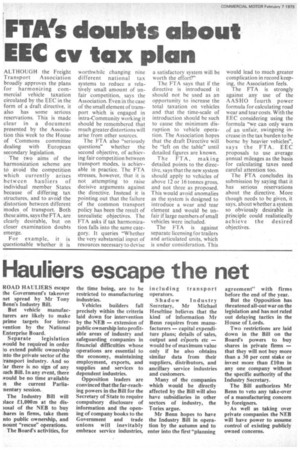FTA's doubts about EEC cv tax plan
Page 24

If you've noticed an error in this article please click here to report it so we can fix it.
ALTHOUGH the Freight Transport Association broadly approves the plans for harmonizing commercial vehicle taxation circulated by the EEC in the form of a draft directive, it also has some serious reservations. This is made clear in a document presented by the Association this Week to the House of Commons committee dealing with European secondary legislation.
The two aims of the harmonization scheme are to avoid the competition which currently arises between hauliers of individual member States because of differing tax structures, and to avoid the distortion between different modes of transport. Both these aims, says the FTA, are clearly desirable, but on closer examination doubts emerge.
For example, it is questionable whether it is worthwhile changing nine different national tax systems to reduce a relatively small amount of unfair competition, says the Association. Even in the case of the small element of transport which is engaged in intra-Community working it should be remembered that much greater distortions will arise from other sources.
The FTA also "seriously questions" whether the second objective, of achieving fair competition between transport modes, is achievable in practice. The FTA stresses, however, that it is not attempting to raise decisive arguments against the directive. Instead it is pointing out that the failure of the common transport policy has been the result of unrealistic objectives. The FTA asks if tax harmonization falls into the same category. It queries "Whether the very substantial input of resources necessary to devise a satisfactory system Will be worth the effort?"
The FTA says that if the directive is introduced it should not be used as an opportunity to increase the total taxation on vehicles and that the time-scale of introduction should be such to cause the minimum disruption to vehicle operation. The Association hopes that the draft Directive will be "left on the table" until detailed figures are known.
The FTA, making detailed points to the directive, says that the new system should apply to vehicles of above 12 or 16 tonnes gross, and not three as proposed. This would avoid anomalies as the system is designed to introduce a wear and tear element and would be unfair if large numbers of small vehicles were included.
The FTA is against separate licensing for trailers and articulated units, which is under consideration. This would lead to much greater complication in record keeping, the Association feels.
The FTA is strongly against any use of the AASHO fourth power formula for calculating road wear and tear costs. With the EEC considering using the formula "we can only warn of an unfair, swingeing increase in the tax burden to be borne by heavier vehicles", says the FTA. EEC proposals to use average annual mileages as the basis for calculating taxes need careful attention too.
The FTA concludes its submission by saying that it has serious reservations about the directive. More though needs to be given, it says, about whether a system so obviously desirable in principle could realistically achieve the desired objectives.












































































































































